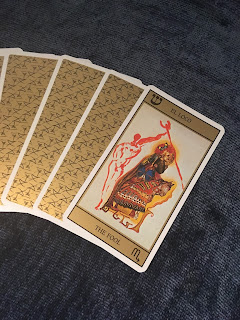Interpreting Tarot Aesthetics
Taromancy is an art in and of itself, and part of that art is interpreting the illustrations that are unique to each deck.
A Note on Dualities: I dislike “black and white” symbolism (literal and figurative) because it erases the gray areas in between. Consciousness isn’t split in two, but the product of an exchange between the conscious, subconscious, and unconscious aspects of ourselves, which both influence and are influenced by each other.
Look for narrative elements in a card like:
An intuitive approach to tarot art reaps the most benefits in my experience, but studying the cards’ history and aesthetic elements helps build a larger pool of knowledge for your mind to draw from when crafting an interpretation.
Analyzing art has writing applications as well. Literature and film rely on aesthetics and symbols to convey their message. Even though written art is not necessarily a visual medium, it still creates images in the mind.
Below are some approaches to analyzing the art and style of tarot illustrations. Formal art analysis and cultural analysis can be especially helpful if your tarot deck didn't come with a booklet or you don't have access to one.
Formal Analysis
Art interpretation often begins with form: What are the different elements of the piece and what do they convey? This can help with interpreting tarot illustrations that are more abstract. Artistic elements include:- Color: What do the author’s color choices convey to you?
- Composition: Is the work balanced or asymmetrical; cohesive or chaotic? What appears in the center of the piece? What is in the background? What is rendered larger or smaller than others?
- Line: Which lines depict movement, depth, contrast, emotion etc. and why?
- Pattern: Do you notice any repetition or themes?
- Space: Does the negative space--the blank areas--serve a purpose?
- Technique: How did the artist apply their materials? Can you see brush strokes or sketched lines? Is the style messy or clean? Do they use one material or mixed mediums?
- Tone: What do the highlights and shadows convey?
Cultural Analysis
Take a deeper look into the external factors that influenced the illustration or the tarot deck as a whole. Ask:- What artistic movement(s) influenced this artist?
- Does the art allude to other works of art or literature, film, religion, myth, etc?
- What historical events, concepts, or figures appear in this piece?
- Does it depict a clear setting or time period?
- What is the cultural symbolism of the colors present?
- Does the art reference any sub-cultures, counter-cultures, or pop-culture?
| The High Priestess |
Example: Artistic Devices in the High Priestess Card
For the following example, I’ll be using the Rider-Waite version as a reference since it’s the most common image for this card.
Here the High Priestess is perched on a throne and wears a diadem to convey her queenly status: one who rules with divine knowledge. The crown occupies quite a lot of space, implying that the mind is the most important aspect here. As the central figure of the card, she is the obvious focus here.
Her robes are blue, the color of creativity. This color also appears behind her, along with moon imagery, so it seems she is connected to the sky and the element Air.
The tapestry depicts pomegranates, symbols of fertility and an allusion to the goddess Persephone. This implies that cisgender femininity is connected to this card.
You can see the duality between dark and light shown in the columns flanking her, a representation of the conscious and subconscious mind.
A Note on Dualities: I dislike “black and white” symbolism (literal and figurative) because it erases the gray areas in between. Consciousness isn’t split in two, but the product of an exchange between the conscious, subconscious, and unconscious aspects of ourselves, which both influence and are influenced by each other.
Similarly, characters are not Good or Bad but in constant conflict between the two, which themselves are subject to interpretation. Characters can also be amoral: outside the binary of right and wrong.
There’s also a whole slew of negative connotations involving black-white color symbolism and race in Tarot (and pretty much any product of Western culture) that are best to avoid.
Narrative Analysis
Tarot cards call to mind images and associations that form simple stories in our heads to explain whatever question we’re seeking answers to. Some cards might not have this element for you. Personally, the Rider-Waite cards don't evoke a narrative for me, but I feel that my Dali deck does.Look for narrative elements in a card like:
- Characters: Who or what appears to hold significance?
- Conflict: Do you see a tension or opposition between two people or things?
- Mood: How does this illustration make you feel?
- Point of View: Where is the art’s lens? Focused, far away, inside, above?
- Tone: What is the artist’s attitude toward the subject?
No one but the artist can truly know the intentions of their work, and even then, external forces and subconscious processes influence the art outside their control. While it’s useful to learn from the artist what they think their piece means, your reaction to it is just as important in shaping its meaning.
Listen to your intuition and research cards that hold significance to you so you can create your own unique and informed interpretations of tarot art.


Comments
Post a Comment